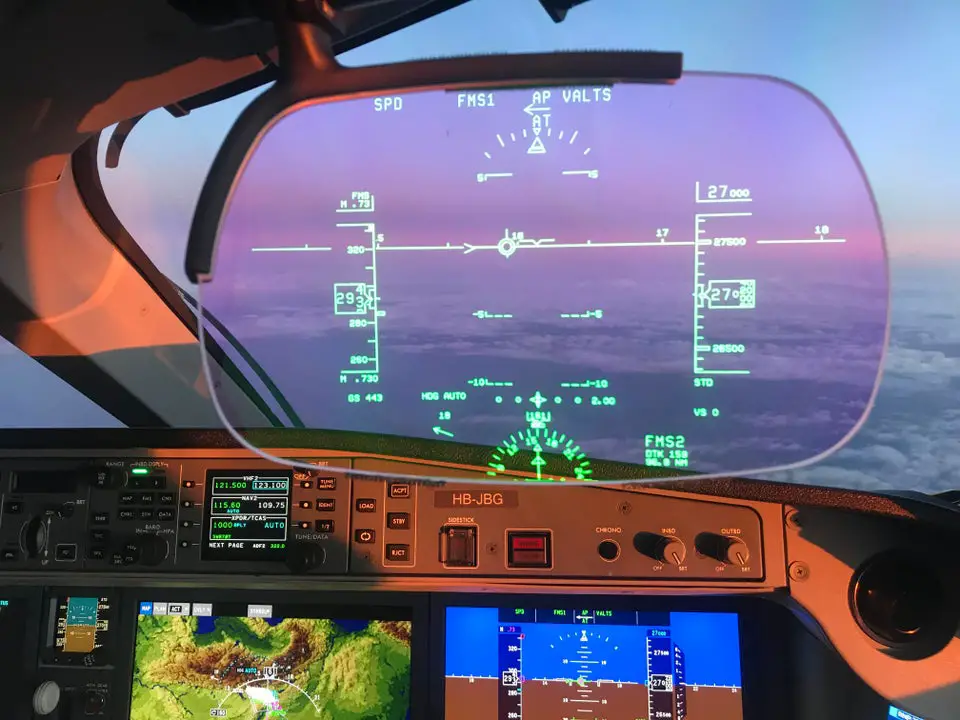The cockpits of modern commercial aircraft are technological marvels, packed with features that aid pilots in their work. One example is the heads-up displays (HUDs) on a plane. But how exactly do they function? Let’s figure it out!
What is a “heads-up display”?
A HUD, or head-up display, is an instrument that projects important flight instrument data onto a small, transparent screen that is placed directly in front of the pilot’s line of sight as they look out the front of the aircraft. The name of the technology comes from the fact that the pilot need not tilt their head from an upright position to view the display of data from the instruments. It differs from other displays mounted lower in the cockpit because of this. Heads-up displays have the benefit of keeping the pilot’s eyes on the world around them while viewing and mentally processing the data in front of them.
What do Heads-Up-Displays (HUDs)display?

Heads-up displays can display a variety of data relevant to an aircraft’s operations at a given moment in time. However, FAA requires the following aspects in be displayed:
- Altitude
- Airspeed
- Heading
- Horizon Line
- Turb and slip/turn and bank indicator
But what else can a Heads-Up-Display (HUD) display?
A typical early HUD displayed a combination of situational and guidance data. The majority of this information was obtained from the Primary Flight Display (PFD) head-down display (HDD) or equivalent analogue instruments. Since the early days of the Electronic Flight Instrument System, the size of HDD EFIS screens has increased significantly, allowing much more information to be displayed on a primary flight display (PFD) and thus on a corresponding HUD.

Image source: AMEC
The original airspeed, altitude, localizer, and glideslope were quickly joined by key derivative information on the aircraft’s energy status – a flight path (trend) vector (FPV). This was followed by a flight-path marker, an airspeed trend vector, an angle-of-attack indication, and a fictitious runway depiction. Landing-flare cues, tail strike warning, unusual-attitude and wind shear detection and recovery guidance, stall margin indications, and Airborne Collision Avoidance System (ACAS) alerts and advisories are all available on some systems.
In low visibility landings or rejected takeoffs, runway distance remaining and ground deceleration displays can be a critical aid in preventing runway excursion. One currently available deceleration display indicates braking performance as 1, 2, 3, or MAX, which correspond directly to autobrake settings, allowing for a clear display of any unexpected runway surface contaminant status during the landing roll.
Components of the Heads-Up-Display (HUD) system

Image Source: Thales
It is worth noting, first and foremost, that this technology has evolved over time, with each generation operating in a slightly different manner. The HUD system usually include:
- An overhead unit for mounting the cathode ray tube (CRT), liquid-crystal display (LCD) or light-emitting diode (LED) which projects the assembled image onto the pilot’s transparent display screen.
- A computer that receives data from aircraft and generates display symbology.
- The transparent display screen, known as a combiner, is a ‘holographic optical element’ made of glass or plastic that reflects the projected image towards the pilot’s eyes while allowing ambient light to pass through.
- An annunciator panel to provide HUD status and warning information.
- A control panel that allows the pilot to select different display options and enter data not received and integrated by the computer from aircraft sensors.

Heads-up displays, like Enhanced Flight Vision Systems (EFVS), have their origins in military aircraft. In this domain, pilots may benefit from the use of helmet-mounted displays, in which the display moves in tandem with the pilot’s head. Modern fighter jets typically have both this technology and a traditional HUD, but the Lockheed Martin F-35 Lightning II only has a helmet-based system. HUDs. The Boeing 787 was the first large commercial aircraft to include HUD as standard equipment.

Image source: Aviation Today
Sources:
Youssef Yahya is the CEO and Founder of Aviation for Aviators, a platform dedicated to the aviation industry. With over 3 years of experience as an aviation writer, Youssef is passionate about sharing his insights on aviation, entrepreneurship, and the broader business landscape. As a Teaching Assistant in Entrepreneurship at Nile University, he also nurtures the next generation of entrepreneurs. When he’s not exploring the skies or business ventures, you can find him saying, ‘Drag your coffee, and let’s talk aviation, entrepreneurship, and football.’
You might also like:
- What Are the Different Types of Airlines and How Do They Operate?
- Delta Air Lines Seeks Compensation Following the Recent Global IT Outage
- Tara Air Flight Crashes With 22 People On Board
- Aircraft Fuel Dumping and What Happens to the Fuel Dumped?
- Emirates to Offer High-Speed Inflight Broadband on 50 New Airbus A350s
Discover more from Aviation for Aviators
Subscribe to get the latest posts sent to your email.

